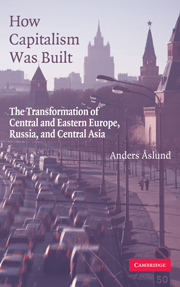Book contents
- Frontmatter
- Contents
- List of Tables and Figures
- List of Abbreviations
- Acknowledgments
- Introduction: A World Transformed
- 1 Communism and Its Demise
- 2 Shock Therapy versus Gradualism
- 3 Output: Slump and Recovery
- 4 Liberalization: The Creation of a Market Economy
- 5 From Hyperinflation to Financial Stability
- 6 Privatization: The Establishment of Private Property Rights
- 7 An Inefficient Social System
- 8 Democracy versus Authoritarianism
- 9 From Crime toward Law
- 10 The Role of Oligarchs
- 11 The Impact of the Outside World
- Conclusions: A World Transformed
- Bibliography
- Index
5 - From Hyperinflation to Financial Stability
Published online by Cambridge University Press: 05 September 2012
- Frontmatter
- Contents
- List of Tables and Figures
- List of Abbreviations
- Acknowledgments
- Introduction: A World Transformed
- 1 Communism and Its Demise
- 2 Shock Therapy versus Gradualism
- 3 Output: Slump and Recovery
- 4 Liberalization: The Creation of a Market Economy
- 5 From Hyperinflation to Financial Stability
- 6 Privatization: The Establishment of Private Property Rights
- 7 An Inefficient Social System
- 8 Democracy versus Authoritarianism
- 9 From Crime toward Law
- 10 The Role of Oligarchs
- 11 The Impact of the Outside World
- Conclusions: A World Transformed
- Bibliography
- Index
Summary
When communism collapsed, macroeconomic chaos prevailed. In late 1991, salespeople stood behind the counters of the large Moscow grocery stores, but they had absolutely nothing to sell. Even the last inedible fish and vegetable conserves had been sold out. Long lines lingered outside other shops, which had received some substandard meat. The lines could last for days, and entrepreneurial organizers distributed numbers to the queuing public, but the produce distributed could scarcely pass for meat. In the Russian language, the verbs “buy” and “sell” had been replaced by “take” and “give,” showing how unequal Russians perceived the exchange between goods and money. Some kolkhoz (collective farm) markets that sold private produce existed, but they were few and their prices were several times higher than the official state prices. People stopped going to work because they could not use the money they earned, and they needed the time for queuing. Life was hell.
When prices were deregulated, they skyrocketed in almost all transition countries. Many major steps had to be taken to achieve reasonable price stability. First, national currencies had to be established. Second, fiscal policy had to be tightened. Third, a new tax policy was needed. Fourth, monetary policy also had to be made strict. Fifth, the exchange rate had to be unified and devalued to become competitive. Alas, these tasks were complex, and the local knowledge of macroeconomics was minimal. The very institutions of macroeconomic policy had to be built or rebuilt. The dramas of financial stabilization engaged all.
- Type
- Chapter
- Information
- How Capitalism Was BuiltThe Transformation of Central and Eastern Europe, Russia, and Central Asia, pp. 104 - 142Publisher: Cambridge University PressPrint publication year: 2007



